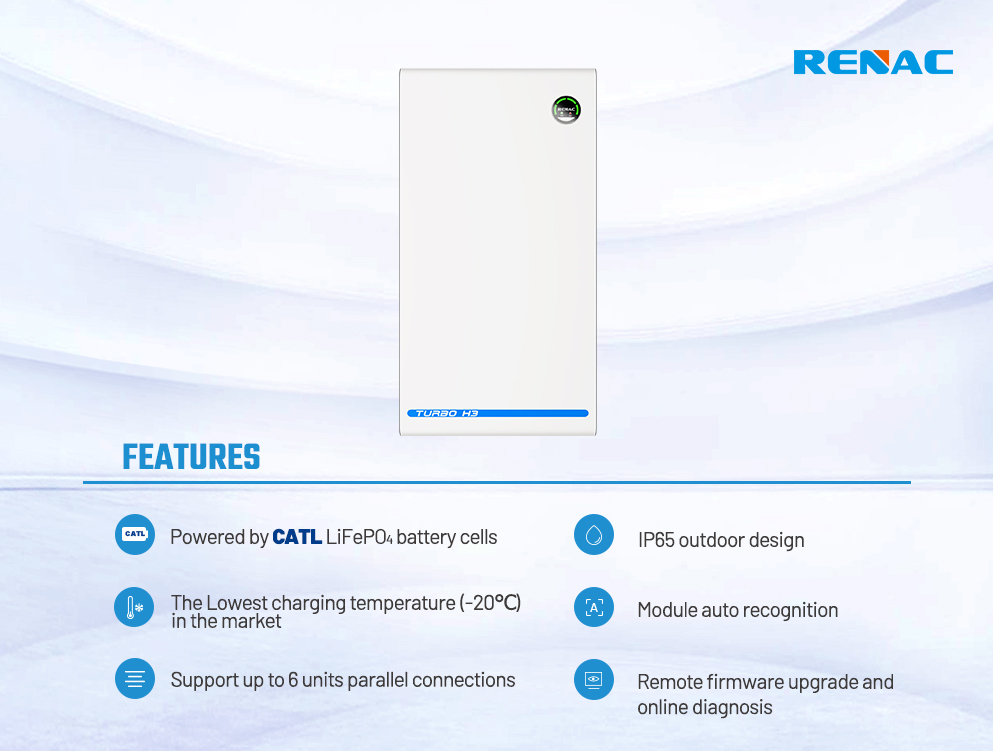Residential energy storage system, also known as household energy storage system, is similar to a micro energy storage power station. For users, it has higher power supply guarantee and is not affected by external power grids. During periods of low electricity consumption, the battery pack in household energy storage can be self-charged for backup use during peak or power outages.
Energy storage batteries are the most valuable part of a residential energy storage system. The power of the load and the power consumption are related. Technical parameters of energy storage batteries should be carefully considered. It is possible to maximize energy storage batteries’ performance, reduce system costs, and provide greater value for users by understanding and mastering technical parameters. To illustrate the key parameters, let’s take RENAC’s Turbo H3 series high-voltage battery as an example.
Electrical Parameters
① Nominal Voltage:Using Turbo H3 series products as an example, the cells are connected in series and parallel as 1P128S, so the nominal voltage is 3.2V*128=409.6V.
② Nominal Capacity:A measure of the storage capacity of a cell in ampere-hours (Ah).
③ Nominal Energy:In certain discharge conditions, the battery’s nominal energy is the minimum amount of electricity that should be released. When considering the depth of discharge, the usable energy of the battery refers to the capacity that can actually be used. Due to the depth of discharge (DOD) of lithium batteries, the actual charge and discharge capacity of a battery with a rated capacity of 9.5kWh is 8.5kWh. Use the parameter of 8.5kWh when designing.
④ Voltage Range:The voltage range must match the input battery range of the inverter. Battery voltages above or below the inverter’s battery voltage range will cause the system to fail.
⑤ Max. Continuous Charging / Discharging Current:Battery systems support maximum charging and discharging currents, which determine how long the battery can be fully charged. Inverter ports have a maximum current output capability that limits this current. The maximum continuous charging and discharging current of the Turbo H3 series is 0.8C (18.4A). One 9.5kWh Turbo H3 can discharging and charging at 7.5kW.
⑥ Peak Current:Peak current occurs during the charging and discharging process of the battery system. 1C (23A) is the peak current of the Turbo H3 series.
⑦ Peak Power:Battery energy output per unit time under a certain discharge system. 10kW is the peak power of the Turbo H3 series.
Installation Parameters
① Size & Net Weight:Depending on the installation method, it is necessary to consider the load bearing of the ground or wall, as well as whether the installation conditions are met. It is necessary to consider the installation space available and whether the battery system will have a limited length, width, and height.
② Enclosure:A high level of dust and water resistance. Outdoor use is possible with a battery that has a higher degree of protection.
③ Installation Type:The type of installation that should be performed at the customer’s site, as well as the difficulty of the installation, such as wall-mounted/floor-mounted installation.
④ Cooling Type:In the Turbo H3 series, the equipment is naturally cooled.
⑤ Communication Port:In the Turbo H3 series, communication methods include CAN and RS485.
Environmental Parameters
① Ambient Temperature Range:The battery supports temperature ranges within the working environment. There is a temperature range of -17°C to 53°C for charging and discharging Turbo H3 high-voltage lithium batteries. For customers in northern Europe and other cold regions, this is an excellent choice.
② Operation Humidity&Altitude:Maximum humidity range and altitude range that the battery system can handle. Such parameters need to be considered in humid or high-altitude areas.
Security Parameters
① Battery Type:Lithium iron phosphate (LFP) and nickel-cobalt-manganese ternary (NCM) batteries are the most common types of batteries. LFP ternary materials are more stable than NCM ternary materials. Lithium iron phosphate batteries are used by RENAC.
② Warranty:Battery warranty terms, warranty period, and scope. Refer to “RENAC’s Battery Warranty Policy” for details.
③ Cycle Life:It is important to measure the battery life performance by measuring the cycle life of a battery after it has been fully charged and discharged.
RENAC’s Turbo H3 series high-voltage energy storage batteries adopt a modular design. 7.1-57kWh can be expanded flexibly by connecting up to 6 groups in parallel. Powered by CATL LiFePO4 cells, which are highly efficient and perform well. From -17°C to 53°C, it offers excellent and low temperature resistance, and is widely used in outdoor and hot environments.
It has passed rigorous testing by TÜV Rheinland, the world’s leading third-party testing and certification organization. Several energy storage battery safety standards have been certified by it, including IEC62619, IEC 62040, IEC 62477, IEC 61000-6-1 / 3 and UN 38.3.
Our aim is to help you gain a better understanding of energy storage batteries through the interpretation of these detailed parameters. Identify the best energy storage battery system for your needs.







